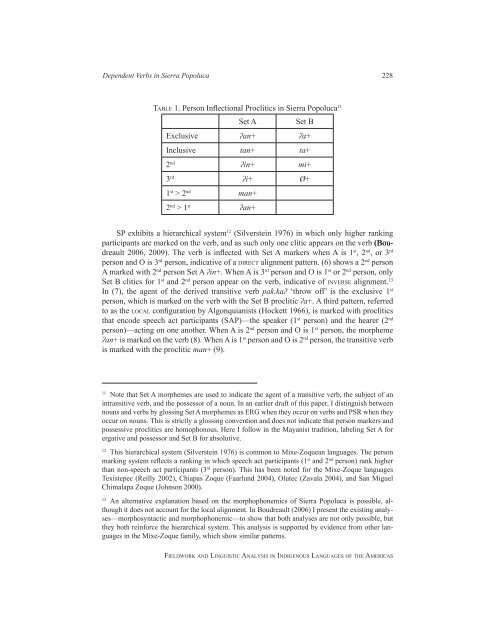Fieldwork and Linguistic Analysis in Indigenous ... - ScholarSpace
Fieldwork and Linguistic Analysis in Indigenous ... - ScholarSpace
Fieldwork and Linguistic Analysis in Indigenous ... - ScholarSpace
Create successful ePaper yourself
Turn your PDF publications into a flip-book with our unique Google optimized e-Paper software.
Dependent Verbs <strong>in</strong> Sierra Popoluca 228<br />
table 1. Person Inflectional Proclitics <strong>in</strong> Sierra Popoluca 11<br />
Set A Set B<br />
Exclusive ʔan+ ʔa+<br />
Inclusive tan+ ta+<br />
2 nd ʔ<strong>in</strong>+ mi+<br />
3 rd ʔi+ Ø+<br />
1 st > 2 nd man+<br />
2 nd > 1 st ʔan+<br />
SP exhibits a hierarchical system12 (Silverste<strong>in</strong> 1976) <strong>in</strong> which only higher rank<strong>in</strong>g<br />
participants are marked on the verb, <strong>and</strong> as such only one clitic appears on the verb (Bou- (Boudreault<br />
2006, 2009). The verb is <strong>in</strong>flected with Set A markers when A is 1st , 2nd , or 3rd person <strong>and</strong> O is 3rd person, <strong>in</strong>dicative of a direct alignment pattern. (6) shows a 2nd person<br />
A marked with 2nd person Set A ʔ<strong>in</strong>+. When A is 3rd person <strong>and</strong> O is 1st or 2nd person, only<br />
Set B clitics for 1st <strong>and</strong> 2nd person appear on the verb, <strong>in</strong>dicative of <strong>in</strong>verse alignment. 13<br />
In (7), the agent of the derived transitive verb pak.kaʔ ‘throw off’ is the exclusive 1st person, which is marked on the verb with the Set B proclitic ʔa+. A third pattern, referred<br />
to as the local configuration by Algonquianists (Hockett 1966), is marked with proclitics<br />
that encode speech act participants (SAP)—the speaker (1st person) <strong>and</strong> the hearer (2nd person)—act<strong>in</strong>g on one another. When A is 2nd person <strong>and</strong> O is 1st person, the morpheme<br />
ʔan+ is marked on the verb (8). When A is 1st person <strong>and</strong> O is 2nd person, the transitive verb<br />
is marked with the proclitic man+ (9).<br />
11 Note that Set A morphemes are used to <strong>in</strong>dicate the agent of a transitive verb, the subject of an<br />
<strong>in</strong>transitive verb, <strong>and</strong> the possessor of a noun. In an earlier draft of this paper, I dist<strong>in</strong>guish between<br />
nouns <strong>and</strong> verbs by gloss<strong>in</strong>g Set A morphemes as ERG when they occur on verbs <strong>and</strong> PSR when they<br />
occur on nouns. This is strictly a gloss<strong>in</strong>g convention <strong>and</strong> does not <strong>in</strong>dicate that person markers <strong>and</strong><br />
possessive proclitics are homophonous. Here I follow <strong>in</strong> the Mayanist tradition, label<strong>in</strong>g Set A for<br />
ergative <strong>and</strong> possessor <strong>and</strong> Set B for absolutive.<br />
12 This hierarchical system (Silverste<strong>in</strong> 1976) is common to Mixe-Zoquean languages. The person<br />
mark<strong>in</strong>g system reflects a rank<strong>in</strong>g <strong>in</strong> which speech act participants (1 st <strong>and</strong> 2 nd person) rank higher<br />
than non-speech act participants (3 rd person). This has been noted for the Mixe-Zoque languages<br />
Texistepec (Reilly 2002), Chiapas Zoque (Faarlund 2004), Olutec (Zavala 2004), <strong>and</strong> San Miguel<br />
Chimalapa Zoque (Johnson 2000).<br />
13 An alternative explanation based on the morphophonemics of Sierra Popoluca is possible, although<br />
it does not account for the local alignment. In Boudreault (2006) I present the exist<strong>in</strong>g analyses—morphosyntactic<br />
<strong>and</strong> morphophonemic—to show that both analyses are not only possible, but<br />
they both re<strong>in</strong>force the hierarchical system. This analysis is supported by evidence from other languages<br />
<strong>in</strong> the Mixe-Zoque family, which show similar patterns.<br />
fieldwork <strong>and</strong> l<strong>in</strong>guistic analysis <strong>in</strong> <strong>in</strong>digenous languages of the americas

















